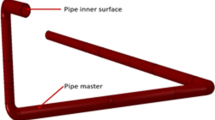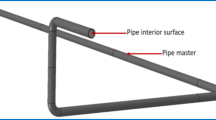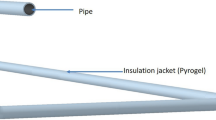Abstract
The possibility of creep–fatigue interaction occurring in steam pipes of power generation plants during operation has been on the front burner for years. Often, failure of the pipes during operation is attributed to either creep alone or fatigue alone. Of recent, some failures are speculated to be due to simultaneously coupled interaction between creep and fatigue, especially when the failure occurs earlier than anticipated. The literature shows that such studies are very limited and indeed under-researched. Thus, there is a dire need to systematically investigate this coupled creep–fatigue phenomenon and provide clarity as the failure of high-pressure steam piping has consequential and very significant effects on the suppliers and end users. In this work, a special Fortran user subroutine script of a phenomenological modified hyperbolic sine creep model was developed and implemented in Abaqus CAE/2019 finite element code to initially determine the creep behavior of a P91 steam piping network subjected to a typical daily start-up and shutdown cycle. Subsequently, fe-safe/TURBOlife software was employed to investigate whether the failure induced by the start-up and shutdown cycles was due to fatigue alone, creep alone or due to creep–fatigue interaction. Interestingly, the study showed that the failure of the piping network under the specified operating conditions is specifically due to creep alone. Furthermore, the intrados of the elbow in the piping network was identified as the region most prone to failure, and the piping network will only survive a total of 7.1 and 7.7 years under these operating conditions for both machined and fine-machined surfaces, respectively. These results were thereafter analytically validated, and it showed a strong correlation with the numerically determined creep rate.


















Similar content being viewed by others
References
H. Jing et al., Finite element simulation of creep–fatigue crack growth behavior for P91 steel at 625°C considering creep–fatigue interaction. Int. J. Fatigue 98, 41–52 (2017)
V. Shlyannikov, A. Tumanov, N.J.E.F.M. Boychenko, A creep stress intensity factor approach to creep–fatigue crack growth. Eng. Fract. Mech. 142, 201–219 (2015)
X. Zhang et al., Creep–fatigue endurance of 304 stainless steels. Theor. Appl. Fract. Mech. 71, 51–66 (2014)
R.J.F. Hales, A quantitative metallographic assessment of structural degradation of type 316 stainless steel during creep–fatigue. Fatigue Fract. Eng. Mater. Struct. 3(4), 339–356 (1980)
K. Sadananda, P.J.M. Shahinian, Effect of environment on crack growth behavior in austenitic stainless steels under creep and fatigue conditions. Metall. Trans. A 11(2), 267–276 (1980)
J.-F. Wen et al., Simulations of creep crack growth in 316 stainless steel using a novel creep-damage model. Eng. Fract. Mech. 98, 169–184 (2013)
B. Fournier et al., Creep–fatigue–oxidation interactions in a 9Cr–1Mo martensitic steel. Part I: effect of tensile holding period on fatigue lifetime. Int. J. Fatigue 30(4), 649–662 (2008)
Dassault Simulia Systemes, fe-safe/TURBOlife User Manual (Providence, RI, 2017), p. 122
L. Zhao et al., Analysis of creep crack growth behavior of P92 steel welded joint by experiment and numerical simulation. Mater. Sci. Eng. 558, 119–128 (2012)
T. Hyde et al., Creep crack growth data and prediction for a P91 weld at 650°C. Int. J. Press. Vessels Pip. 87(12), 721–729 (2010)
M. Saber, W. Sun, T.J.E.F.M. Hyde, Numerical study of the effects of crack location on creep crack growth in weldment. Eng. Fract. Mech. 154, 72–82 (2016)
Z. Ding et al., Modeling of fatigue crack growth in a pressure vessel steel Q345R. Eng. Fract. Mech. 135, 245–258 (2015)
V. Bolotin, I.J.P. Belousov, Early fatigue crack growth as the damage accumulation process. Probab. Eng. Mech. 16(4), 279–287 (2001)
H. Li, H. Yuan, X. Li, Assessment of low cycle fatigue crack growth under mixed-mode loading conditions by using a cohesive zone model. Int. J. Fatigue 75, 39–50 (2015)
R.M. Code, Design and Construction Rules for Mechanical Components of FBR Nuclear Islands and High Temperature Applications, Appendix A16, Tome I, vol. Z (AFCEN, Paris, 2007)
A. Boiler, Rules for Construction of Pressure Vessels (American Society of Mechanical Engineers, New York, 2013)
R.A. Ainsworth, R5: Assessment Procedure for the High Temperature Response of Structures (British Energy Generation Ltd, 2003)
M.J. Chrzanowski, Use of the damage concept in describing creep–fatigue interaction under prescribed stress. Int. J. Mech. Sci. 18(2), 69–73 (1976)
L. Xu et al., A novel creep–fatigue interaction damage model with the stress effect to simulate the creep–fatigue crack growth behavior. Int. J. Mech. Sci. 130, 143–153 (2017)
D. Annaratone, Cylinders under internal pressure. Press. Vessel Des. 47–125 (2007)
B. Kanlıkama, A. Abuşoğlu, İ.H. Güzelbey, Coupled thermoelastic analysis of thick-walled pressurized cylinders. Int. J. Energy Power Eng. 2(2), 60–68 (2013)
A. Kandil, A. El-Kady, A. El-Kafrawy, Transient thermal stress analysis of thick-walled cylinders. Int. J. Mech. Sci. 37(7), 721–732 (1995)
V. Pesonen, Online Creep and Fatigue Monitoring in Power Plants (2014)
F. Garofalo, An empirical relation defining the stress dependence of minimum creep rate in metals. Trans. Metall. Soc. AIME 227(2), 351–355 (1963)
J.M. Montes, F.G. Cuevas, J. Cintas, New creep law. J. Mater. Sci. Technol. 3(28), 377–379 (2012)
R. Skelton, D.J. Gandy, Creep–fatigue damage accumulation and interaction diagram based on metallographic interpretation of mechanisms. Mater. High Temp. 25(1), 27–54 (2008)
J.-F. Wen, S.-T. Tu, A multiaxial creep-damage model for creep crack growth considering cavity growth and microcrack interaction. Eng. Fract. Mech. 123, 197–210 (2014)
J. Lemaitre, A. Plumtree, Application of damage concepts to predict creep–fatigue failures. J. Eng. Mater. Technol. 101(3), 284–292 (1979)
W. Ramberg, W.R. Osgood, Description of stress–strain curves by three parameters. Nasa Scientific and Technical Facility Report (1943), pp. 1–32
R. Lagneborg, R.J.M.T. Attermo, The effect of combined low-cycle fatigue and creep on the life of austenitic stainless steels. Metall. Trans. 2(7), 1821–1827 (1971)
Dassault Simulia Systeme, ABAQUS 6.13 User’s Manual (Providence, RI, 2013)
T. Rasiawan, The Influence of Prior Creep Damage on the Fracture Localisation in X20 CrMoV12-1 Cross-Weld Creep Tests (University of Cape Town, Cape Town, 2017)
Pyrogel-XTE-Datasheet, High-Performance Aerogel Insulation for Industrial and Commercial Applications
S. Salifu et al., Thermo-mechanical stress simulation of unconstrained region of straight X20 steam pipe. Proc. Manuf. 35, 1330–1336 (2019)
Y. Gorash, D.J.O.E. MacKenzie, On cyclic yield strength in definition of limits for characterisation of fatigue and creep behaviour. Open Eng. 7(1), 126–140 (2017)
M.E. Fine, Y.W. Chung, Fatigue Failure in Metals, vol. 19 (ASM International, 1996)
Acknowledgments
This research has been profusely supported by Tshwane University of Technology and the University of Pretoria, South Africa. Also, the authors greatly appreciate the unending support of Eskom Power Plant Engineering Institute (Republic of South Africa).
Author information
Authors and Affiliations
Corresponding author
Additional information
Publisher's Note
Springer Nature remains neutral with regard to jurisdictional claims in published maps and institutional affiliations.
Rights and permissions
About this article
Cite this article
Salifu, S., Desai, D. & Kok, S. Creep–Fatigue Interaction of P91 Steam Piping Subjected to Typical Start-up and Shutdown Cycles. J Fail. Anal. and Preven. 20, 1055–1064 (2020). https://doi.org/10.1007/s11668-020-00908-8
Received:
Published:
Issue Date:
DOI: https://doi.org/10.1007/s11668-020-00908-8




